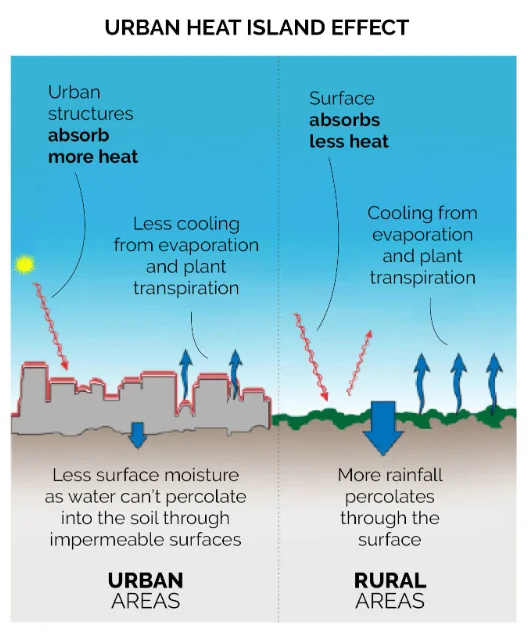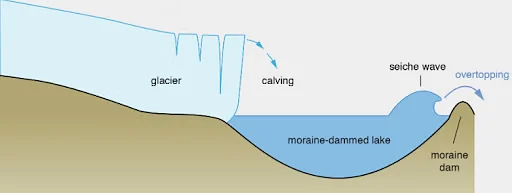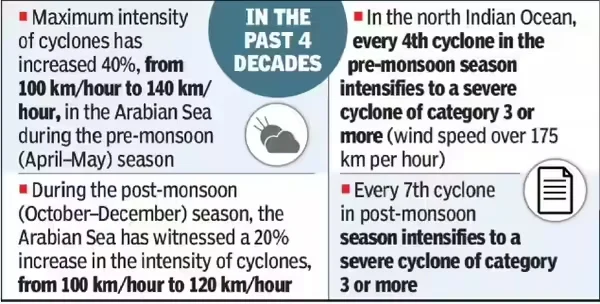From Relief to Resilience in Disaster Management
This editorial is based on “India's disaster risk financing needs to evolve as new options emerge” which was published in The Livemint on 08/05/2024. The article brings into picture the fundamental paradox in India's disaster management framework: despite successive Finance Commissions strengthening funding mechanisms, the country's vulnerabilities continue to escalate.
For Prelims: Natural disasters, Cyclones, 2004 Indian Ocean Tsunami, Cyclone Remal, National Disaster Management Authority, Extreme weather events, Heat waves, Disaster Management Act of 2005, Sendai Framework for Disaster Risk Reduction, Hyogo Framework for Action, Cyclone Biparjoy, 2022 Joshimath land subsidence crisis.
For Mains: Key Disaster Threats India is Facing, Measures India can Implement to Build a More Robust Disaster Resilience System
India's disaster management framework faces a fundamental paradox: while successive Finance Commissions have strengthened funding mechanisms, the country's vulnerabilities continue to escalate, with economic losses from disasters now exceeding ₹50,000 crore annually. The devastating impact of recent cyclones like Amphan and Tauktae, floods across Bengaluru, Assam and Chennai, and landslides in Wayanad underscore how disasters crash into lives and economies with alarming regularity. The question is no longer whether India can afford to invest in disaster preparedness, but whether it can afford not to fundamentally reimagine its approach to building resilience against an increasingly unpredictable climate future.
What are the Key Disaster Threats India is Facing?
- Extreme Heatwaves and Urban Heat Island Effect: India is facing escalating heatwaves due to climate change, exacerbated in cities by the Urban Heat Island effect.
- Poor infrastructure, lack of green cover, and reflective surfaces make urban centers deadly during summer. It also disproportionately affects the elderly, outdoor workers, and slum populations.
- In 2024, Delhi recorded 49.9°C. IMD noted a notable rise in heatwave days between 2000–2020 across north India.
- Glacial Melts and Himalayan Flooding: Accelerated glacial melt in the Himalayas due to global warming is triggering flash floods and landslides. These events are made worse by rampant hydro-projects and deforestation in fragile zones.
- The threat is transboundary, impacting Nepal, Bhutan, and northern Indian states alike.
- The 2023 Sikkim flood killed 74 after a glacial lake burst. ISRO found 2,000+ Himalayan glacial lakes at high risk.
- Cyclones Intensifying in Arabian Sea: Cyclones are increasing in frequency and severity in the Arabian Sea, a new shift historically rare for India’s west coast. Warming oceans are energizing storms, endangering coastal states like Gujarat, Maharashtra, and Kerala.
- Urban coastal populations and port economies are highly vulnerable. Cyclone Biparjoy (2023) was the longest Arabian Sea cyclone, displacing 94,000 people in Gujarat.
- Flooding and Urban Drainage Collapse: Monsoons now frequently cause urban floods due to poor drainage, encroachments, and infrastructure failure. Rapid unplanned urbanization worsens impermeability and waterlogging. Climate variability leads to short, high-intensity rains overwhelming systems.
- In July 2023, Delhi saw Yamuna reach its highest level in 45 years, inundating key areas.
- Earthquake Risk in the Himalayan Belt and Northeast: Seismic risk remains under-addressed in India’s north and northeast, both in high seismic zones. Poor enforcement of building codes and informal construction increase vulnerability. The region is overdue for a major quake, experts warn.
- Over 58% of Indian land is earthquake-prone (NDMA). In March 2024, a 6.6 magnitude quake in Afghanistan shook Delhi, highlighting transboundary seismic risk.
- Water Scarcity and Droughts: Over-extraction, monsoon variability, and inefficient agriculture are deepening India’s water crisis. Central and southern states are increasingly drought-prone, with declining groundwater tables. The crisis has socio-economic and interstate conflict dimensions.
- Over 70% of India's groundwater is overdrawn (CWC, 2023). Marathwada saw 8 consecutive drought years; Karnataka-Tamil Nadu Cauvery dispute flared again in 2023.
- Forest Fires and Biodiversity Loss: Rising temperatures and dry spells are increasing forest fire frequency in ecologically sensitive zones. Poor forest management, human activity, and invasive species intensify the problem. These fires threaten biodiversity, tribal livelihoods, and carbon sinks.
- In 2024, Uttarakhand saw major forest fire incidents in 4 months. FSI reported a notable increase in vulnerable fire-prone areas compared to 2004.
- Sea Level Rise and Coastal Erosion: India’s 7,500 km coastline is under threat from rising sea levels, leading to saline intrusion and land loss. Coastal livelihoods, ports, and tourism are at stake. Mangrove destruction and sand mining worsen natural defenses.
- Chilika Lake has experienced a remarkably high erosion rate of 19.87 meters per year. Sundarbans islands are sinking 2–3 mm annually.
What Makes India's Existing Disaster Management System Inadequate for Modern Disaster Challenges?
- Legacy Framework Focused on Relief, Not Resilience: India’s disaster response remains reactive—focused on post-disaster relief, not risk reduction or resilience building. Structural mitigation, early warnings, and climate adaptation are still underemphasized.
- NDMA lacks binding enforcement authority and strategic agility. Cyclone Amphan (2020) caused $13B damage despite early warnings—pointing to poor structural readiness.
- Inadequate Local Governance and Decentralization: Disaster planning is top-down; local bodies lack funds, autonomy, and technical capacity to respond.
- Gram Panchayats and ULBs are poorly integrated into risk planning. This limits real-time response, especially in rural and peri-urban India.
- Less than 10% of districts have updated disaster management plans (NDMA, 2024). In 2023, many villages in Himachal faced landslides without local evacuation protocols.
- Poor Integration of Climate Science into Risk Planning: The DM framework ignores shifting baselines—like increased glacial floods or urban heatwaves—driven by climate change. Risk assessments use historical, not dynamic or predictive, data. Climate variability is treated as episodic, not systemic.
- Uttarakhand floods (2023) highlighted failure to anticipate glacial lake outburst risk zones.
- Urban Fragility and Infrastructure Collapse: Rapid urbanization outpaces the disaster management system’s capacity to handle infrastructure failure. Drainage, power grids, healthcare and transport systems are highly brittle in metros.
- Urban floods, fires, and building collapses are becoming chronic.
- For instance, Bengaluru floods (2022) affected ₹225 crores in losses to IT companies.
- Technology Gaps in Forecasting and Early Warning Systems: India’s early warning systems lack granularity, real-time dissemination, and last-mile delivery. Forecasting does not cover non-cyclonic events like heatwaves, forest fires, and flash floods adequately. Multi-hazard systems remain fragmented.
- Heatwave alerts cover only a few states despite 23 being vulnerable (IMD, 2024).
- Fragile Critical Supply Chains and Interdependencies: Disasters now disrupt national food, fuel, and digital supply chains due to high interconnectivity. Current frameworks do not assess cascading risks across sectors. A localized event can now trigger multi-sectoral breakdowns.
- During Cyclone Biparjoy (2023), Kandla Port disruption impacted fertilizer logistics.
- Underfunded and Incoherent Institutional Architecture: NDMA, SDMAs, and DDMAs remain under-resourced, overlapping, and poorly coordinated. Their mandates often clash with development authorities and ministries.
- Disaster management is not mainstreamed into regular governance.
- Also, Private industries and communities are marginal in current planning—despite their exposure to risk and potential for resilience. CSR is rarely directed toward risk reduction. Communities lack training, drills, or decision-making power.
What Measures Can India Implement to Build a More Robust Disaster Resilience System?
- Institutionalize Climate-Risk Mainstreaming in Urban and Infrastructure Planning: India must embed dynamic climate-risk indices into smart city, housing, transport, and energy infrastructure policy.
- This includes zoning reforms, resilience benchmarks in urban bylaws, and climate-proofed master plans.
- Spatial planning should integrate predictive hazard mapping, not just historical vulnerability. Urban planning must shift from expansionist to climate-adaptive design.
- Establish Decentralized Multi-Hazard Risk Mapping and Action Cells: Every district must host a real-time multi-hazard monitoring cell equipped with AI-driven predictive tools, GIS layers, and local contingency protocols.
- These units should coordinate with Panchayats and city wards for last-mile action. Risk mapping should cover compound events like floods plus epidemics or earthquakes plus fires.
- Build a National Resilience Fund with Dedicated Capex for Mitigation: Instead of reactive relief budgets, India must earmark a capital expenditure-driven “National Resilience Fund.”
- This should finance embankments, retrofitting, natural buffers, green infrastructure, and early warning infrastructure. A rules-based fund disbursement mechanism linked to performance metrics should guide usage.
- Codify a Disaster-Resilient Infrastructure Code for All Sectors: Develop a mandatory “Disaster Resilient Infrastructure Code” applicable to railways, power grids, ports, schools, and telecom.
- All public infrastructure should be designed or retrofitted to withstand specific local risks like seismic loads, floods, or cyclonic winds. It must be legally binding and audited annually.
- Create Risk-Sensitive Financial Instruments and Insurance Ecosystems: Develop scalable parametric insurance models for droughts, floods, cyclones, and crop loss, especially for MSMEs, farmers, and informal workers.
- Link microfinance and risk-pooling mechanisms with local cooperatives. Encourage banks and FPOs to offer resilience-linked credit to high-risk zones.
- Institutionalize Community-Led Early Warning and Response Protocols: Promote “Risk Committees” in every village and urban slum to design, drill, and execute response protocols based on local knowledge.
- Equip them with basic digital tools and rapid-response kits. Empower women, SHGs, and youth collectives as first responders through routine capacity building.
- Integrate Disaster Resilience into Public Health Systems: Redesign primary healthcare centers (PHCs) as climate-resilient units with surge capacity for floods, heatwaves, or vector outbreaks. Embed health surveillance, mobile medical units, and telemedicine into district disaster plans.
- Align state disaster authorities with the National Health Mission for hazard-health convergence.
- Institutionalize Disaster Risk Education in Curriculum and Workforce Training: Make disaster preparedness and climate resilience part of formal school curricula, vocational training, and civil services modules.
- Public-sector employees, teachers, contractors, and panchayat workers must be trained in localized emergency handling. Use simulations, drills, and gamified e-learning platforms.
- Legally Mandate Private Sector Continuity Planning and CSR Risk Financing: Make it compulsory for industries, SEZs, and corporate clusters to maintain “Business Continuity and Resilience Plans.”
- CSR regulations must prioritize disaster preparedness and ecosystem restoration in vulnerable zones. Set up a joint public-private emergency response financing mechanism.
- Restore and Protect Natural Buffers Through Eco-DRR Models: Adopt ecosystem-based disaster risk reduction (Eco-DRR) by restoring mangroves, floodplains, wetlands, and forest corridors.
- Use nature-based solutions for slope stabilization, urban cooling, and water absorption. Institutionalize green buffers into land use plans and link them to carbon-credit finance streams.
- Build a National Cadre of Climate and Disaster Professionals: Establish a specialized service—like a “Disaster and Resilience Services Cadre”—with domain experts in geoinformatics, urban risk, humanitarian logistics, climate adaptation, and emergency medicine.
- Rotate them across SDMAs, research agencies, and ground deployments for rapid professionalization.
Conclusion:
To build a disaster-resilient India, the current reactive framework must evolve into a proactive, climate-smart, and locally-empowered system. Integrating technology, equity, and ecosystem-based strategies is no longer optional—it’s urgent. Disaster risk reduction must be mainstreamed across all sectors, not siloed as an emergency response. This aligns squarely with the Sendai Framework’s priorities: risk understanding, governance, resilience investment, and preparedness for “Build Back Better.”
|
Drishti Mains Question: "India’s disaster management framework remains largely reactive and structurally misaligned with emerging climate-linked disaster risks." In the light of this statement, critically examine the limitations of India’s current disaster governance and suggest a resilient, multi-hazard risk reduction approach in line with the Sendai Framework. |
UPSC Civil Services Examination Previous Year Question (PYQ)
Mains:
Q. Discuss the recent measures initiated in disaster management by the Government of India departing from the earlier reactive approach. (2020)
Q. Vulnerability is an essential element for defining disaster impacts and its threat to people. How and in what ways can vulnerability to disasters be characterized? Discuss different types of vulnerability with reference to disasters. (2019)
Q. Describe various measures taken in India for Disaster Risk Reduction (DRR) before and after signing ‘Sendai Framework for DRR (2015-30)’. How is this framework different from ‘Hyogo Framework for Action, 2005’? (2018)



